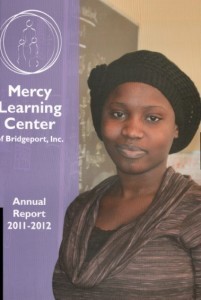Mariann S. Regan's Blog, page 3
October 28, 2012
And the Walls Come Tumbling Down
This is the third blog in the series,
A Search for the Living Descendants of Curley Kirven
My research during the last two days has yielded both big finds and dashed hopes.
Recap: I believe my great-grandfather Erasmus had a biracial son, Tom, with Annie Tony (probably a slave) in 1855. Tom’s death certificate names his parents.
It seems that Tom had several children, among them a son Curley, the informant on Tom’s death certificate. Curley Kirven and Charlotte Kirven had four children, with these birth years as estimated by the 1920 and 1940 censuses:
Ida May, b. 1914
Lillian, b. 1916
Josh, b. 1917
Tom, b. 1919 (named after Curley’s father)
These four children would be my biracial second cousins.
In my last blog post, I guessed Ida May’s and Lillian’s married surnames. I was so wrong! I’ve found the correct names now, but I won’t reveal them here.
Two days ago, I started researching Josh and Tom. First, I looked for their death certificates on ancestry.
Eureka! I found them both! Beginner’s luck. Tom’s SSDI says he died in South Carolina in the 1980s. Josh’s says he died there in the 1990s . . . but wait! I see a CT death index for a Josh Kirven who died on that same day, in Waterbury, CT. What?
So I searched for the two brothers’ obituaries in the RCPL database (Richland County Public Library, South Carolina). Months ago, some unrelated searches of this same database had given me correct but skimpy obituaries. So my hopes were low. I expected to find obituaries that would tell me little more about Josh and Tom.
Oh, my. Eureka and beginner’s luck again! The full-text obituaries for Josh and Tom mentioned spouses, children, grandchildren, the married surnames of their sisters, resident cities, a church name, and even some work history. Many, many thanks for the expert help of the Local History Manager of the RCPL, Debbie Bloom, recommended by Robin Foster of @savingstories and @LCAfricana.
Here was matter for more research. Bright hope in a dim landscape, like fall flowers and foliage (we’re talking symbols here):
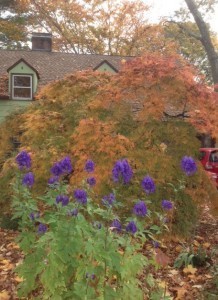
Our front yard today: Monkshood before a Japanese Cut-Leaf Maple
Apparently, Josh and Tom had moved North soon after 1940 to work in the Waterbury Rolling Mills, in Waterbury, Connecticut. Josh had worked there 50 years, and died in Waterbury in the 1990s. That meant I had been living right down the turnpike from these two biracial cousins for three decades! For in 1964 I also had moved North, to live first in New Haven and then in Fairfield. This fact alone was a head-smacking discovery.
So now, what about the children of my four biracial second cousins?
(1) Ida May is in the 1940 census with her married surname and husband, but no children. I looked for them in the white pages today, in the resident city named in the obituaries. But neither is listed there now, almost 100 years after Ida May’s birth. A Peoplesmart search of the surname alone gave me 30 results—yet none of the first names are remotely familiar. [Note: Use message boards to search for the children or grandchildren of this couple.]
(2) Lillian’s married surname is a common one. Her resident cities are “the Bronx” and “New York.” Although I searched the 1940 census with her birth year and married name, I found nothing useable. For example, listed in Manhattan was a Lillian, with a husband and two very young daughters. These daughters, grown and married, would then be two surnames removed—needles in a haystack.
(3) Neither obituary mentioned Josh’s children, if any. His wife in Waterbury survived him, but she is not in the white pages there today. [Note: Look for her DC and obituary.]
So far, my hopes were being dashed or semi-dashed, one by one. My remaining options seemed slim.
(4) But Tom, the youngest child of Curley Kirven, had three children mentioned in his obituary. Grandchildren, too! Surely some living people lay down this path. (No given names or surnames are mentioned beyond this point.) I searched again.
One son died at age 34. [Note: Search further for his DC and obituary.]
A second son seems to be in prison in Virginia. For $40.00 to Peoplesmart, I could see the precise charges. [Note: This further search is an option.]
At this point I began to feel a bit manic. Like the laughing baby in this video, who seems to enjoy tearing up documents—hmmm, as if he were a genealogist going bonkers after too many dead-end searches:
This is a short and funny video. You’ll like it.
Then finally, one last Eureka happened to me. I said “Eureka” softly, so as not to tempt the fates. Tom’s third child is a daughter, whose married surname had been mentioned in his obituary. Good old Peoplesmart revealed her phone number and address, and her secure email, for $30.00.
This is good, I told myself. This is still a great “find.”
My relatives and I will now try to contact this woman. Just as we tried to contact “A,” several posts ago.
Maybe this was not an “exhaustive” search, but it was surely an exhausting one . . . . . . Zzzzzzzz.
October 24, 2012
One Brick Pried Loose
This is the second blog in the series,
A Search for the Living Descendants of Curley Kirven
Oh, goodness gracious sakes alive! (Yes, that’s a Southernism.) How could I have missed the plain fact that Curley and Charlotte Kirven and their children are in the 1940 Census?
Here’s how. I made assumptions. Always dangerous.
First assumption: My family typically stayed put. Darlington County is where our Kirvens began, and many have stayed there through the years.
Result of first assumption: When the original (not indexed)1940 census arrived, I scoured each entry for Darlington County, page by page through 46 districts. It took me a week. I was looking for Curley, Charlotte, and any one of their four children. They were not there. I put the project aside for a while.
Second assumption: African-Americans often migrated northward, to escape the oppressive Jim Crow South.
Result of second assumption: Earlier, when I couldn’t find Curley and Charlotte in the 1930 Census, I assumed that they must have re-settled in some Northern state. Then when I also didn’t find them in the original 1940 Census for Darlington County, my assumption was reinforced. (And I thought I was using historical context! Oh, well.)
Hmmm. I notice that these two assumptions contradict each other. Go figure.
Then, Surprise! Curley and his family reappear in the 1940 Census. I’m extremely grateful to @mitzs for pointing out this fact to me earlier today. They are in Lee County, South Carolina, just southwest of Darlington County, in the town of Cypress.
Curley is still a farmer, working now for an employer (E) instead of on his own account (OA) as in 1920. He works 52 weeks a year, for pay. During the sample week March 24-30, 1940, he worked 60 hours. His son Tom, 21, is an unpaid family worker (NP).
Curley’s other son Josh, married to Rebecca, lives on the next farm. He also works 52 weeks a year, and 40 hours during the sample week.
On Google Maps, Cypress is no longer a town. But the Lee County School District is only 10 miles from Lydia, Darlington, where Curley’s father Tom died. These Kirvens would have been living close to home, as our family’s Kirvens typically do.
In the 1940 Census I first-name-searched Curley’s two daughters, Ida May and Lilian. Their given names and birth years matched those of two women living in Darlington County:
Lilian Murry (b. 1916) lives with her husband Darse in Philadelphia, Darlington County. Their children are Joseph, Magaline, Olin, and Jessie Mae.
Ida Mae Thomas (b. 1914) lives with her husband Buston in Swift Creek, Darlington County. Their children are Edward Lee and James Lee.
And yet, I still can’t find Curley and his family in the 1930 Census. (Am I missing the obvious here?) I’ve searched the 1930 Census for Curley Kirven and Charlotte Kirven (phonetically) in Lee County, Darlington County, and the USA. Guess I’ll just have to solve this mystery later. I wonder whether the WPA and CCC databases would be useful?
For now, I believe I should move to city and county directories. Maybe I can trace Curley’s children forward through their addresses. This would be a new pursuit for me. My genealogy friends tell me that it can be done. . . .
If any of Curley’s four children were living now, they would be in their 90s:
Ida May, born 1914
Lilian, born 1916
Josh, born 1917
Tom, born 1919
Most likely, I will be be searching for these children’s children.
More genealogy adventures in the next post.
Tips about city and county directories are especially welcome!
Step Up to the Brick Wall
A means to an end—that’s what genealogy is for me.
The end is to connect with living family—to celebrate, understand, and create a better future. Genealogy brings knowledge. And knowledge empowers us to do some good in our little corner of the world.

The maple (yellow for hope) in our own front yard
Last summer our family gathered together 80 first-cousins-plus-descendants for a festive Reunion. Many of us were meeting for the first time. With the help of charts and family trees, we learned exactly how we were related. We “did good,” I think.
Now I’m searching for our mulatto second cousins, descended from our great-grandfather the South Carolina planter. Several of my kin, along with me, want to find these biracial relatives, talk with them, and listen carefully to them. Maybe together we can start to inch past the old days of slavery and racism. I’m just sayin’.
Why? Some people ask me. Why would you ever want to do such a thing?
Just idealistic, I guess. In our country, it was people who created wounds from racial differences, and I’m betting it will be people who can heal these wounds – with enough knowledge, respect, and compassion for one another.
This belief helped motivate me to write my family memoir (link), and it has also spurred me to work at the Mercy Learning Center:
Four mornings a week I volunteer here as a tutor. Bridgeport has 35,000 adult women without literacy skills. In practice, this situation is a racial divide that stems from de facto racial inequalities in public education. Here at MLC, over 600 women (representing 51 countries) work to strengthen their literacy and numeracy skills. Many go on to earn their GEDs. Here are their ethnicities and ages:
In this same spirit of connection and knowledge, I’d like to help bridge the silence and ignorance that now separates white from their (as yet unknown) mulatto relatives across our country. We carry one example of that silence within our own extended family, because our white ancestors, who owned slaves, in some instances had children by slaves. Their descendants are our current reality. Can we talk?
I think I may have already found one living biracial second cousin – but as I explained in my latest blog post, he did not answer my letter or email. He has no voice mail. At 85 years old, is he perhaps unwell? Has he moved? Might he be reluctant to respond?
I don’t know. But I’m not giving up now, not by a long shot. I’m searching for other biracial cousins and second cousins.
First in a Series: A Search for the Living Descendants of Curley Kirven
Curley Kirven, born in 1892, seems to be the mulatto grandson of my g-grandfather and a black slave woman.
For me, he is a path toward living biracial relatives.
This path has turned into a brick wall.
So. I’m going to blog my search for Curley’s descendants, step by step, in a series of posts starting today. I’ll look at every relevant database that my friends in genealogy have suggested or will suggest. I’ll try to consider historical context. Maybe my amateurish efforts will help others to learn (or teach) genealogy. Advice is always welcome!
If I approach the present, I will omit the names of living people, for their privacy.
Here goes.
Documented Evidence:
Curley Kirven is the informant listed on the Death Record of Thomas Kervin, who died on 6 Jan, 1921 in Lydia, Darlington, SC.
Thomas was born 15 Sept 1855 to a father “Erasitus Kervin” and a mother “Annie Tony” both of Darlington County, according to his Death Record. Annie Tony is listed as black (B) in other census records. In 1855 she would likely have been a slave.
My great-grandfather was Erasmus Kirven, a white Darlington planter (1817-1897).
Tom Kirven, mulatto (Mu), born abt. 1854, is a farmer with a wife and young daughter (Mu), all listed on the 1880 Census for Leavensworth, Darlington, SC. He lived and farmed close to the home of my great-grandfather, Erasmus Kirven. (This wife and daughter are not found in later censuses. I yearn in vain for an 1890 census.)
Tom E. Kirven, black (B), born abt. 1853, is a farmer with a different wife and seven children, all listed on the 1900 Census for Leavensworth, Darlington, SC. Curley is one of his sons, with birth date “Feb 1892.”
Thomas E. Kervin, mulatto, born abt. 1853, and his son Curley, mulatto, born abt. 1892, are listed as father and son in the 1910 Census for Lydia, Darlington, SC.
Note: The variety of spellings (Kirven/Kervin/Kirvin) and race abbreviations (Mu, B,) are typical. A person’s birth year often varies from one census to another. Lydia and Leavensworth and Epworth (below) are in the same area of Darlington County.
My tentative conclusion: Tom, Thomas or Tom. E. [Erasmus?] Kervin/Kirven is the son of Erasmus Kirven (white) and Annie Tony (black). Tom’s son, Curley Kirven, would have been my mother’s mulatto half-cousin.
What about descendants of Thomas and Curley? My most important clue, so far, is the 1920 census:
Here Curley Kirvin, his wife Charlotte, and their four children Ida May, Lilian, Josh, and Thomas are living in Epworth, Darlington. The letter under “Color” for Curley is blurred. Perhaps it is Mu with a B written over it, a sign of changing census codes. Curley is a farmer. His home is rented. He is not on a salary or wage, but is working on his own account (OA).
After 1920, Curley reappears in only two documents, a Social Security application in 1957 and a SSDI in 1964. I have found no further record of his wife or his children.
In my next post (soon, I hope!), the search for Curley’s descendants will continue. What do I need to know and where can I look next? I have a few ideas and sources lined up.
All ideas welcome!
Sources:
South Carolina Death Records, 1821-1955, ancestry.com
1880 Federal Census Records, ancestry.com
1900 Federal Census Records, ancestry.com
1910 Federal Census Records, ancestry.com
1920 Federal Census Records, ancestry.com
October 9, 2012
Found. Now, Contact?
Ring. Ring. Surreal suspense. If he answers his phone, his family and ours could possibly dive together into 200 years of family history.
He is likely my second cousin—even though he is mulatto and I am white. We both may be great-grandchildren of the same man, a South Carolina planter born in 1817. Almost 200 years ago.
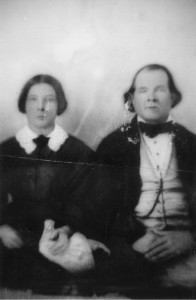
Great-Grandmother Mary Caroline and Great-Grandfather Erasmus in the mid-1800s
But no one answers. The rings finally stop.
That was two days ago.
I first learned of this possible second cousin over a month ago. He is 85 years old.
First, I emailed him through Peoplesmart’s secure service. I identified myself by age, occupation, race, and phone. I said my research had suggested that he and I were related, and I’d really appreciate being able to talk with him, “if it is all right with you.” I tried to be deferential and straightforward.
No response. In a few days, I mailed him a letter that repeated my email, and added that we might want to compare great-grandparents. So now he had my phone number, my address, my plea, and my intent.
No reply to my letter. So I waited until two days ago, when I phoned him.
Ring. Ring. No answer.
What is my evidence that this man may be my second cousin? Census records, church minutes, death certificates, family rumors, and plain old probability. Some selected “finds,” without names (to preserve the privacy of the living):
This man has the same name as a person (call him A) who appears through census records to be my second cousin. The 1940 U. S. Census lists A as born in 1927, so A would be 85. This man is 85.
Both this man and A bear our family surname and a first name used within our family. Both are from the same South Carolina town. In the 1800s, our family lived in that town and the surname was well known.
This man is the only person in the United States today with this particular first name and surname.
A’s mulatto grandmother was born in 1847, according to census reports. In mid-1849 my great-grandfather was expelled from a Baptist church on an unproven charge of bastardy—that is, fathering an illegitimate child—according to the church minutes.
A’s father appears as a mulatto boy in the 1880 and the 1900 censuses. In 1880 he has the surname of his mulatto mother’s black husband. But in 1900 this same mulatto boy has a new surname—our family’s surname. What has changed? One thing: in 1900 the mulatto boy’s black grandmother has joined the household. She may have argued for the name change.
The mulatto boy’s black grandmother (A’s great-grandmother) is listed as “Mother” on the 1921 death certificate of another mulatto man, B, who has our family’s surname. Listed there as B’s “Father” is my great-grandfather, whose name is unusual and unmistakable. B’s birth year is 1855. He was born into slavery. In 1880, after slavery, B and his own family lived close to my great-grandfather and farmed a plot of land.
I am inferring this hypothesis: My great-grandfather had two mulatto children by the same black woman, who was a slave: (1) a daughter born in 1847 (A’s grandmother) and (2) a son, B, born in 1855. This black woman may have decided that each of these children should bear my great-grandfather’s surname, for both did.
I believe genealogists call this a “collateral line.” While all traces of ancestors hold meaning, I am the type of (amateur) genealogist who seeks especially to find the living.
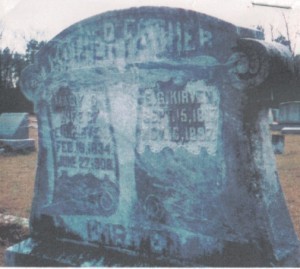
The tombstone shared by my great-grandmother and great-grandfather. Across the top, MOTHER and FATHER are written in capital letters
I believe the man I found on Peoplesmart is likely to be A, my second cousin. When I first discovered him listed among the living, I emailed some family members who live near him, to ask whether they would like to approach him. I had prepared them for this kind of “find” at last summer’s reunion.
Two relatives were enthusiastic about reaching out to this man. They were eager to learn more about his family history and ours, and to know whether he has children. Two others were not interested. “Better let well enough alone,” they said. The rest told us to do whatever we thought best. One cousin even said: “If he shows up here, I’ll welcome him into my home.”
Involving my family members felt positive to me. Thomas DeWolf and his family had a similar reaction when they learned their ancestors had been famous and rich Northern slave-traders: They sent letters to 200 of their relatives. Ultimately, ten family members joined an expedition to retrace the steps of those slave-trading ancestors. DeWolf’s cousin, Katrina Brown, filmed the trip and made a PBS documentary, Traces of the Trade. DeWolf published a memoir in 2008, Inheriting the Trade.
Contacting family members about a disturbing family history is not all roses. I spoke briefly with DeWolf on September 10th, through Bernice Bennett’s Blog Talk Radio. Dewolf said that a number of his relatives were not pleased that he was focusing on their family’s slave-trading history. He added that members of Edward Ball’s family, about a decade ago, were upset with him for writing Slaves in the Family.
But DeWolf also told me that after resisting at first, some of his family and Ball’s family are “coming around” toward a positive view. I’m glad. When your ancestors have participated in historical atrocities, it’s good to acknowledge that reality. Once you admit fact, you can start unraveling the hows and whys of human nature. You can move toward healing. I’ve tried to do that in my family memoir, Into the Briar Patch, which studies the effects of owning slaves upon my ancestors and their descendants.
On Bennett’s September 10th program, I asked a question of her other guest, Sharon Morgan, who is DeWolf’s new co-author. How should a person approach a biracial relative who descends from slaves owned by that person’s family? This is my case. Sharon advised this straightforward statement: “Through research I have found that we’re related. I would really appreciate being able to talk with you.” She also said to keep trying for contact—since the message might not get through at first.
I’m taking Sharon’s advice, and I’m grateful for it.
Sharon Morgan descends from slaves, while Tom DeWolf descends from slave traders. Their new co-authored book—released today, October 9th—is entitled Gather at the Table: The Healing Journey of a Daughter of Slavery and a Son of the Slave Trade.
Tom and Sharon believe in the work of Coming to the Table, an organization that helps people acknowledge and heal the wounds from racism that are rooted in our history of slavery. Here, the descendants of slavery and slaveholders can meet. George Geder sent me the link to Coming to the Table during Bennett’s Blog Talk Radio session with Tom and Sharon.
In fact, George Geder and Robin Foster were the ones who told me about Bernice Bennett’s series of programs. Grateful shout-outs to all three!
Coming to the Table promotes truth, listening, and the long work of reconciliation. I would like to participate in this vital work, in whatever small way our family can.
I’ll try again to contact this man who may be second cousin.
I’ll also keep searching for traces of C, a son of the mulatto man B. I found C in the 1920 census living with a wife and four children . . . but nothing more until his Social Security number in 1957 and his SSDI in 1964. What happened to his children? His descendants would be related to our family.
While A’s (my prospective second cousin’s) phone was ringing, I was filled with surreal anxiety. I’m ready to withstand that kind of anxiety again. Connecting with lost relatives . . . those are high stakes.
August 22, 2012
Before, After, and Coming Soon
Here’s the story. BEFORE our family’s July South Carolina Reunion, The In-Depth Genealogist published an article of mine. It showed my genealogical prep work for welcoming 80 relatives. It reflected how I might share, with some of them, my new evidence that we probably have living biracial kin.
The thing is, we descend from (white) slaveholders. Many families like ours have unacknowledged biracial relatives stemming from slavery days. My July article is at this link: http://www.theindepthgenealogist.com/?page_id=2441
Now it’s AFTER our family’s July South Carolina reunion. The In-Depth Genealogist is about to publish a follow-up article of mine. It describes how our big Reunion went, and how some of my relatives reacted to my hands-on evidence of biracial lines engendered by our ancestors. This article will appear Saturday August 25th, in The In-Depth Genealogist. Just a few days from now.
COMING SOON is another blog post in this space, probably during the first week of September. In the last few days I seem to have located, online, one actual living biracial second cousin and his wife, whom we could contact. I’m checking out this info, to share with certain relatives. We’ll talk, and email, and decide how to proceed. Maybe nothing will happen. Maybe a lot will happen. A bud of information . . . may become a blossom. Surprising what you can discover in your own back yard.
I’m finding it tricky to juggle my own blog with an online publication, especially one so appealing and well appointed as The In-Depth Genealogist. I intend to write for both, but where does the “breaking news” go? Hm. I must figure these things out.
My first real blog was only this past January 18th. For several weeks my blog told the story of how I wrote Into the Briar Patch, my family memoir. Now I’ve moved on to the aftermath – the book’s reception, the family’s responses, the ongoing search for biracial relatives.
In just a few months, all of you on Twitter have taught me volumes about using genealogical resources and gen-technology, about organizing, dealing with brick walls, networking, and so much more . . . especially about how to be a persistent, humane, and ethical genealogist or family historian. I’ll be learning from you for a long time to come. You are a great group.
June 17, 2012
An Evening Salute to My Father
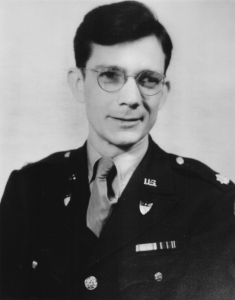
Lieutenant Colonel William Sanders
This is my dad, William M. Sanders. He was a gentle soul.
In 1942, three months before I was born, he left with the U.S. Army to fight World War II. He served in England (during the bombing raids), then in France. He would never, ever talk about his time in the war, and he had no desire to see Europe again. “I’ve already seen it,” he would say.
My mother was beside herself during those war years, although it was some consolation to her that Dad was in the intelligence service, not on the front lines. She kept this picture on her bureau all during WWII. She would rock me and tell me, “Everything will be all right when your father comes home.”
When we met him at the train station, he was shy. I was three and a half years old by then. He sat down beside me and gave me a piece of Wrigley’s chewing gum. Mother had given me the same kind of gum as a present for him. We traded pieces. We didn’t have too much to say at that moment.
I would learn through the years that this was my dad’s nature—shy, reserved, careful, ethical to a fault, punctilious. He tried very hard never to show any anger. Yet he couldn’t control my mother’s temper, or tame her unruly worries. But he never stopped trying.
He was a calm presence around the house. He loved gardening. He grew huge strawberries and tomatoes in the back yard, and we tried to eat them before the birds sampled them. He would search our dog for ticks and then drown them extra carefully in alcohol. He was slow and patient in digging a splinter out of my foot, more than once. He built my little sister a playhouse with curly eaves.
What I remember most vividly about him—what I can still hear today—is his laugh. It was an infectious, drawn-out chuckle. It was also a message, the same one every time. It told me something like this: “People are absurd! They brag, strut, contradict themselves, tell big lies, and will try anything! But hey, we can’t do a thing about it, so let’s laugh!”
He was delighted that his co-worker at the Veterans Administration, George E. Pickett III, was forever bragging about his grandfather’s infamous Confederate military fiasco known as “Pickett’s Charge.” Now, that really tickled my dad.
In his last year of life, his brain stopped finding words for him, so he couldn’t talk. But he could listen. And he still laughed at my jokes. Over the years, I had picked up the fine art of amusing him.
We lost him on Easter Sunday, 1999. All three of us daughters cried without reserve for this reserved, kind man.
Love you, Dad.
May 25, 2012
Asking the Family
None of our relatives are stereotypes. I know that!
But do I, really? My cousins always surprise me with their distinct opinions. “The family” are not all of one mind.
This last week I’ve been calling my relatives, one by one, to solicit their views about my research. The thing is, I’ve discovered some biracial children of our white slaveholder ancestors in South Carolina. I haven’t traced these biracial lines to the present—not yet.
So here is what I’ve asked my relatives:
I’ve found some evidence of biracial descendants in our family, dating from the days of slavery. Are you interested in exploring these connections with me? If I can find some living descendants, should we contact them and offer to meet them, and shake hands with them?
Why am I questioning my relatives this way? My last blog, “Loyalties and Genealogies,” explores my reasons. Since then, I’ve also read Mike Maglio’s good advice in his column “Genealogy as a Minefield” for the May 22nd issue of The In-Depth Genealogist.
He says, “It is important to understand the emotional impact that uncovered family secrets can have. A careful conversation can help map where the trip wires are in your family history minefield.”
If my relatives were stereotypes—Southern stereotypes—I would expect all their answers to be something like this:
Oh, dear! What a scandal! Stop that, Mariann! Don’t do any more research in that direction! Let bygones be bygones!
But they didn’t say that. Not one of them said anything like that. Here’s what they did say:
Relative #1: Well, I’m not at all surprised. That happened to a lot of people during those times. I wonder if they have some of our traits? Well, I guess I’d want to see how they turned out before deciding whether to shake their hand.
Relative #2: Yes, I’m interested to see what you’ve learned. I’ve heard that there are some families in XXX who might be related to us. I’m interested in knowing what the facts are, if you have some facts. It would be good to know some facts as opposed to the rumors that we have been hearing.
Relative #3: I don’t know quite how I feel. I’d have to think about it.
Relative #4: Well, I’m not surprised, and I’m not offended. It offends me that people would want it hidden. Bring on the information. It’s lovely information to have. I don’t see that it’s going to hurt anybody. A reality is a reality. What’s the harm in knowing? It would be interesting to know how their lives [of the biracial relatives] have been, to know them and know who they are.
Relative #5: The line of inheritance is interesting whichever way it goes. It is what it is. It would be ridiculous to ignore it. I am for knowledge and not for no-knowledge. There are no reasons to not know. None of it disturbs or upsets or bothers me.
So. I’m taking these responses at face value. Maybe there are land mines that I’m not yet detecting. We haven’t had a group discussion—maybe we will have, during this summer’s first-cousin reunion.
Meanwhile, my search continues. I’m looking for biracial relatives, and I’m edging quietly toward the present. Soon I may have a few questions for some African-American churches in the area where my family lived.
How should I phrase these questions? I’m working on that. Carefully.
I’d love for people to comment! How do you handle the minefields in your family history? Have you been able to settle differences and reach harmony?
May 11, 2012
Family Loyalties and Genealogies
Family histories console me about death. The vast web of my family’s genealogy seems to transcend each perilous moment of birth and death and display secure relationships between the living and the dead—and thus between the living and the living. I feel supported by the lifelines of those relationships. I identify completely with Lynn Palermo in The Armchair Genealogist when she relates that the sudden deaths of her husband’s father and mother spurred her towards genealogy:
“The frailty of the last year and half had brought me to the realization there was so much I wanted to know about my own history, my own ancestors, I wanted to write those stories.”
Yes. “Those stories” contribute life to my family tree, too. The word “tree” suggests a permanent, live, growing creation. When I watch “Who Do You Think You Are?” and “Finding Your Roots,” I can see that knowing the dead adds meaning to the lives of the living. Thank you, genealogists.
“Those stories” are not always happy. History holds outrages for us, mixed unpredictably with inspirations. It shook me to learn that the evil behemoth of institutional slavery had captured my ancestors, who owned slaves for sixty years. My book Into the Briar Patch explores how slaveholding affected my ancestors’ hearts and minds. Long research taught me to hold back from either blaming or praising them, and instead to concentrate on understanding them. My cousins knew the book would be about some wrenching issues, and even so they were kind and helpful to the point of reading and commenting on my drafts. I’ve tried to be fair, and I’m grateful that reviewers (shout-out “Thank You!” to Caroline Pointer) have called my book clear-eyed, objective, and compassionate. Nevertheless, I find it an ongoing struggle to be open and considerate of everyone. Conflicts do arise.
I’ll try to express here some of these conflicts and possible paths to resolution. E. M. Forster has said, “How do I know what I think till I see what I write?”
We all know that slavery meant sexual relationships between white male slave owners and African-American female slaves, resulting in mixed-race children. One look at our population today shows these relationships were frequent, even commonplace. Many of these relationships were probably coerced, in that great power imbalance, but were all of them coerced? Even though I’m an avowed feminist, I wonder. Only the participants could have answered this question, and then perhaps only in silence to themselves.
In our family there have long been rumors. When I began my research, one dear cousin said to me, only half-jokingly, “Don’t dig too deep, or you may find some black babies.” Another cousin later sent me some printouts from ancestry.com, which I interpreted as clues to our possible mixed-race relatives—documentation of mulatto families who had lived near our family in 1880, 1920, or 1930, and who shared our first names and surnames.
My choice was either to follow up these clues or to shut the book on further investigation. After waiting a while, I followed up the clues. I decided that knowledge is better than intentional ignorance, and that family lines are important. Robin Foster @saving stories has been very generous and encouraging, with her expertise and wide experience. Megan Smolenyak’s fine webinar on “Finding the Living” has given me additional ideas. In my guest post for In-Depth Genealogy on April 28th I’ve presented my first tentative research results—my hypotheses that my great-grandfather, my 2 x great-uncle, and my great-uncle had mixed-race children. I haven’t yet found living descendants of these children.
I’m now informing my cousins about this research, one by one. When/if I do identify living mixed-race relatives, I will talk further with my white relatives. They have each been supremely kind and forthright with me in my research, and I feel that my first loyalty is to them, the family I have known all these years. Would they like to see my findings? Do they want to follow up in some way? I will listen to them carefully.
Low Country Africana on April 23rd tweeted an article about James DeWolf of Massachusetts, who has discovered that his ancestor James DeWolf (b. 1764) of Rhode Island was “the leading slave trader in all of U.S. history.” James then sent letters to 200 of his relatives, asking whether they wanted to explore with him the connections with their shared past. Only 9 of those 200 agreed, but now these ten people have made an Emmy-nominated documentary: “Traces of the Trade: A Story of the Deep North.”
Will any of my relatives want to explore with me the connections with our (still hypothetical) living mixed-race family members? From my experience growing up in the South, I can imagine dozens of reasons for them to say No. But maybe some would say Yes.
Then more questions would arise. Would we try to reach out in some way to our mixed-race relatives, who may or may not want to be contacted? How would that work? This is not a simple question, to me.
Even James DeWolf’s nine consenting relatives, once they learned the totality of the family’s complicity in the slave trade, said they only felt comfortable reaching out to white people, “because they didn’t want to be perceived as white people naively reaching out to black people.” That’s interesting. Is their fear warranted?
I’m vulnerable to naiveté, it’s true. Social concerns can be naïve-making forces. In my utopian fantasies, white Southerners meet their mixed-race Southern relatives in a scene of racial healing. Our ancestors have been through slavery, on either side, and we are the result. Hooray! We don’t need to be afraid or angry. Present humanity can replace the inhumanity of the past. We can meet in justice and friendship.
Well. History is not fantasy. On “Finding Your Roots,” I have witnessed some reunions between blacks and whites. They were positive, yes, but fairly sober. The heavens did not open. In fact, these meetings were follow-ups to DNA testing—one more hurdle for people to consider. Some white people have refused Skip Gates’ request for DNA testing to establish ancestors in common with mixed-race guests on the show.
Moving back to reality, I do feel loyalty to my not-yet-found second and third mixed-race cousins. They are the family I don’t know. Their genealogies, joined to mine, represent for me an additional massive web of relationships that stretch across births and deaths to make a permanent pattern in history. I want to listen to their stories. But would they want to tell me their stories?
Through these loyalties and these genealogies, I feel as if I’m moving an inch at a time. The march of history, in small steps.
April 21, 2012
One Door Closes, but Another Door . . .
Here’s a short recap—before the release of the 1940 census—of my search for mixed-race relatives descended from my white South Carolina ancestors:
Thomas is listed as a mulatto in the 1880 census. His Death Certificate names my great-grandfather Erasmus as his father, and Annie, a black woman, as his mother. Thomas was born in 1855. That’s how I recently learned that Thomas is my great uncle.
Curley, the son of Thomas (mulatto) and Anna (black), was born in 1892. His children would be my second cousins, and their children my second cousins once removed. Can I find them?
I’m following the trail forward. At least, I reflect, there is a trail!
Here’s one trail:
Erasmus & Annie –> Thomas & Anna –> Curley & Charlotte –> Curley’s children
Curley is in the 1900, 1910, and 1920 censuses, with our family surname. In 1910 he is one of seven children living with Thomas and Anna. In 1920 Curley and his wife Charlotte have four children of their own.
Yet Curley disappears from the Census in 1930.
Even when I “got narrow” as suggested by Susan Clark on Caroline Pointer’s blog site by searching for just the first name “Curley” anywhere in South Carolina, I struck out. (“Curley” seems unusual. The lead in Oklahoma is the only “Curley” I know.)
So the 1940 census was a ray of hope for me.
I searched an entire SC county on the 1940 Census, an eye-numbing 1500-plus online pages. No Curley, no Charlotte, none of their children’s first names.
No victory story here.
Yet I discovered I might be in a twisting Sherlock Holmes story, where one clue leads not to the solution but to another clue.
For as I wearily combed through the 1940 Census of the very last district in the county (42 districts!), I found Charlie. He had a wife, Annie, and three children. He also had the family surname.
Where had I seen this Charlie before? Ah, yes. He was an “adopted son” in a 1900 Census household, where the mother-in-law was . . . Annie!
And this Annie was the mother of Thomas, by my great-grandfather Erasmus. Thomas was born in 1855, back in slavery days.
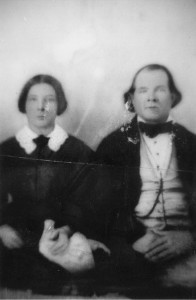
Mary Caroline and Erasmus Goodson Kirven, c. 1850
In the 1900 Census, Annie at age 75 has Charlie listed as an “adopted son,” born in 1879. (Could Charlie be her grandson by her son Thomas? Charlie’s birth date is close to the 1880 Census that lists Thomas living with a wife and newborn daughter. Thomas’s mulatto son Charlie may have been placed with another black family for a while, as seems general practice from census records in this county.)
Also in this household live Annie’s son-in-law James W. (a different surname from ours) and Annie’s daughter Caroline W., born in 1850 and listed as mulatto on the 1880 census. Annie may have named her own daughter Caroline after Erasmus’ wife and my great-grandmother, Mary Caroline. Could Caroline W. have been Erasmus’ mulatto daughter by Annie, born five years before their mulatto son Thomas in 1855? (James and Caroline W. married in 1866, the year after the Civil War.)
So here’s another trail:
Erasmus & Annie –> Caroline
AND
Erasmus & Annie –> Thomas & Lucy –> Charlie & Annie –> Charlie’s children
Hm. Charlie’s children might also be my second cousins, like Curley’s children. Was this a second-best “find”?
On that 1900 census, Charlie bears our family surname. For whatever reason, Annie wanted that surname in her family.
Maybe she fought to keep that surname. On the 1880 census I found Charlie, 2 years old, mulatto, with father James W., black, and mother Caroline W., mulatto. Charlie has James’s W. surname, here. He is listed as “son” and not “adopted son.”
So Charlie’s name and status changed between 1880 and 1900. Did Annie prevail in some conflicted family discussions?
In 1910, Charlie is listed as widowed and mulatto.
In the county Draft Registration records of 1917-18, Charlie lists his birth year as 1876 and his wife Annie (once again, an Annie!) as his nearest relative. In 1930 he and Annie have an “adopted son,” Wilson. Adopted from whom? In 1940 he has another son and a daughter, all teenagers then.
The Death Certificate for Charlie says he died in June 1948 at age 70, which puts his birth year as 1878.
I looked for Charlie’s father. Thomas? Erasmus? Who? But this question drew a blank. The father was listed as D.K. (don’t know). A frustrating item for family researchers.
Did they really not know?
Are these D. K.’s, and adoptions, and variable birth years an effort to hide mixed-race parentage? For the benefit of whom?
Also in the 1940 census, there is a pattern of black families adopting children who keep the surname of well-known white families. Mixed-race parentage might have been a sign of status, as degree of “whiteness” is in some places today. The hierarchies of class and race are a sad phenomenon.
To look for Charlie’s mother, whose name was typed through a used ribbon over Death Certificate print, I “go wide” under Susan Clark’s advice. I search for Ce* and other variants of a first name that looks somewhat like Ceicilna. I come up empty.
Family research is engaging detective work, but difficult. Slippery.
I welcome all advice from readers and genealogy experts! Tips appreciated!
[P. S. In case others can benefit from my mistake: Archives.com appeared on my monitor, advertising their stockpile of records. When they claimed they had Curley’s “birth record,” I took the bait and gave them my credit card number to get a look. But they showed me only the 1900 census. No birth certificate. Buyer beware. I’m going to un-subscribe.]
April 8, 2012
Potholes in the Road to Mixed-Race Relatives: Slow Down
By now, I thought, I would have located my mother's mixed-race cousin, Curley, in the 1940 census.
Curley is the grandson of my white slaveholder great-grandfather, Erasmus. His father, Thomas, born in 1855, was the son of Erasmus and Annie, a black woman. I don't know yet whether Annie was slave or free.
And I may never know whether Erasmus was using Annie to "grow" more slaves (to quote Henry Louis Gates from the latest "Finding Your Roots" episode), or whether it was plain sexual attraction, or whether it was an affair of the heart.
Right now, finding Curley is my goal. He was 8 in the 1900 census. He was 18 in the 1910 census. He was 28 in the 1920 census. Yet the 1930 census does not mention him. (I searched nationally, but in vain.) Curley does not appear again until 1957, to obtain a SSN. He died as "Kirley" in 1964, in the same South Carolina county where he had lived.
Why do I want to find Curley? He is my first known link to any of my mixed-race relatives who may be alive today.
When I learned about the smooth MyHeritage route to the 1940 census (thank you, @rjseaver on geneamusings.com), I looked for Curley in the townships where he lived, in 1900, 1910, 1920, and 1964. No luck.
Well, then, I would just have to search that entire South Carolina county.
The whole county includes 40 townships. At an average of 45 pages per township, that makes 1800 pages.
I'm halfway through, and no Curley/Kirley so far.
In 1940, Curley would be 48, and his wife Charlotte 46. Judging from the 1920 census, their children would be 26 down through 21.
Page by page, I'm recording charts of everyone with the family surname, especially those marked "Neg" (the 1940 abbreviation for African-American).
At the same time, I'm looking for Curley and his family with a different surname. Melvin Collier @MelJCollier on Roots Revealed, in "Ain't Gonna Take Massa's Name," reminds us that African-Americans often shed their slave surname.
In this scenario, as I imagine it, Curley discovered that he had a white grandfather only in 1921, when he signed the death certificate for his father, Thomas. The name was there in plain sight. Curley, shocked and offended, changed his surname.
Therefore, I'm looking on the 1940 census for any of these first names marked "Neg": Curley, Charlotte, and their children Ida May, Lilian, Josh, and Tom—each with any surname whatsoever. I've found a very few of these first names with relevant ages.
Searching for six first names and a surname—that is taking me a while.
There are about 1000 pages left in the county. When I read tweets announcing 1940 census "finds," I feel both inspired and a little let down by comparison.
I don't want to be like the character in Melville's story, "Bartleby, the Scrivener." Bartleby painstakingly recorded so many law documents that one day he simply quit. He said he "preferred not to."
If I mean to keep going, I'll have to slow down my little research car as I bump through these potholes.
This part of the trip is finite. Admittedly, it could fail. But there are more roads to travel. I'm the only car in sight, and I'm in this genealogical journey for the long haul. I need to keep myself in good repair.
This Easter Sunday, I'm taking a short break and tending to my sprouting perennials—columbine, evening primrose, spiderwort, astilbe, geranium, foxglove, wisteria, poppy, and others whose names elude my imperfect memory.
These plants rested during the winter. But here they are once more, renewed.



